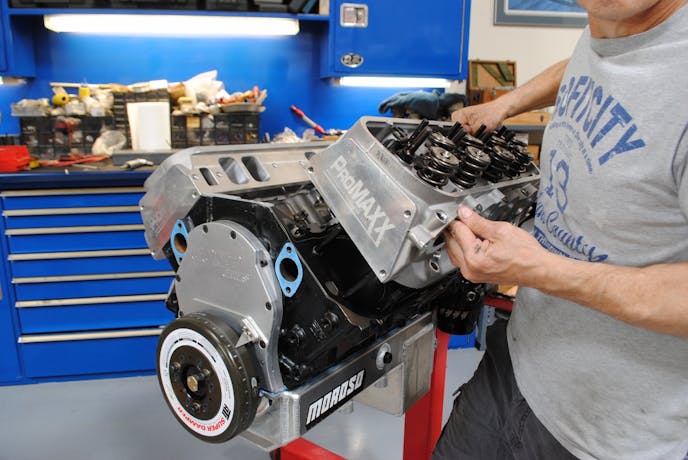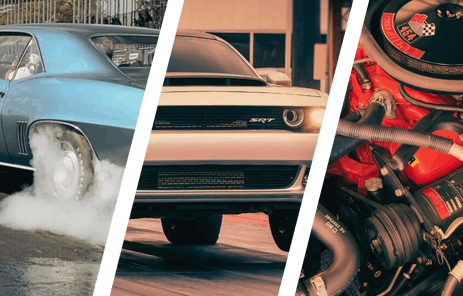
Words and Photos By: Richard Holdener
When it comes to maximum power production, there are a number of different routes available to enthusiasts. Some opt for the easy route, choosing some type of power adder like a turbo, supercharger, or even the good old standby, nitrous oxide. Power adders are certainly capable of dramatically boosting the power output of almost any type of combination, but what if your goal is to do it the old-fashioned way?
The all-motor route is a time-honored tradition that, while slightly more difficult than adding boost or juice, is (for many) ultimately more rewarding. Making power without the use of power adders requires considerable planning and experience on the part of the engine builder. Much more so than when adding boost, all of the critical components must be matched to optimize every last ounce of power production on an NA combo. Missing on just one critical item can ruin a perfectly good combination. Maximum power comes from the selection of parts working harmoniously. There is nothing better than the sweet music of a big-inch motor running at full song.
When it comes to power, major effort is placed on what we call the big three, namely heads, cam, and intake. The other components used in the build-up, like exhaust, carburetion, and even the oiling system, are important, but big power comes mainly from the big three. While thousands of books and untold articles have been written on the “other” components, we focused our attention on a new set of cylinder heads.
Since the internal combustion engine is nothing more than a giant air pump, the more air we can convince our pump to process, the more power it will produce. Potentially confusing, this statement does not suggest we seek merely to maximize the air flow of each individual component. The components must operate together to maximize the flow through the engine as a whole. Simply improving one of the many components may or may not improve the whole. The complex nature of so many individual components working together is why engine builders spend so much time testing different combinations.
This particular dyno session was designed to illustrate the merits of a new set of big-block Chevy cylinders heads offered by ProMaxx Performance. When they began, co-owner Jason Collins set some lofty goals for their line of performance products. Having come from a solid racing background, Jason understood racers (and fellow enthusiasts) needed affordable performance. The goal for ProMaxx was to offer a product line that combined performance, quality, and affordability. Being at odds, the combination of the three variables was a seemingly difficult task. After looking at the results of this test, the gang at ProMaxx might just have pulled off the hat trick.
On paper, the specs on the BBC heads supplied for the test certainly looked impressive. Though ProMaxx offered both smaller, as-cast and larger CNC-ported heads featuring 370cc intake runners, we opted for the middle of the three available heads. The CNC-ported, 340cc versions from ProMaxx featured a 2.30/1.88 stainless (back-cut and swirl polished) valve combo, 122cc combustion chambers, and intake flow that exceeded 400 cfm (peaking at 412 cfm at .900 lift according to their flow bench). ProMaxx supplied our heads all decked out with a triple spring package designed to support our solid-roller cam.
Okay, so we were off to a good start. The CNC porting looked impressive, and the flow numbers seemed to suggest they were at least heading in the right direction, but there was still one question left? How would they perform on an actual engine? Only the dyno could confirm whether the “potential” flow actually translated into power.
To test such impressive heads, we first needed a suitable test motor. Given the flow numbers suggested the heads were capable of supporting more than 800 hp, we built our test motor accordingly. If you go to build big power, never forget that when it comes to motors, bigger is always better. Knowing this, we started by stepping up in the displacement of our test mule. Using a Dart Big M, we filled the big-bore block with forged internals from Lunati and CP. The Lunati Signature Series stroker crank (4.375-inch) and 4340 (6.385-inch) forged rods swung 4.560-inch, CP (11.0:1) forged pistons to produce a final displacement of 572c.i. Maximizing ring seal was a ring package, dialed to perfection using a ring grinding tool and installed using a ring compressor, all from Total Seal.
To take full advantage of the available flow, the big motor needed a suitably big cam. Leafing through the COMP Cams catalog, we selected a solid roller grind that offered a 775/.748 lift split, a 284/292-degree duration split, and 112-degree lsa. COMP Cams also supplied a set of Endure-X roller lifters, hardened pushrods, and an adjustable double-roller timing chain. The finishing touch on the bottom end included a two-piece timing cover and ATI Super Damper.
After completing the bottom end with a Moroso oiling system (pan, pick up, and windage tray), we installed the ProMaxx BBC 340 heads using ARP head studs and Fel Pro MLS heads gaskets. Feeding the heads was an induction combo that included an Edelbrock Super Victor intake manifold and Holley 1050 Ultra Dominator. The Super Victor from Edelbrock was designed to optimize power production higher in the rev range, while the big Holley Dominator ensured plenty of air and fuel for power production. Sparking the air/fuel mixture was an MSD ignition system that included a Pro Billet distributor, plug wires, and Power Grid system.

Big motors make big power, and nothing thumps out power like a big-block Chevy, except an even bigger one. Sporting no less than 572 cubes, this BBC stroker needed plenty of airflow to feed all those extra inches. The ProMaxx Performance heads promised two things we love: plenty of flow and affordable pricing. Equipped with their CNC-ported, 340cc BBC heads (they also offer 370cc versions), this 572 thumped out an impressive 850 hp and 719 lb-ft of torque.
After the break-in cycles, the tuning session included adjustments to jetting, timing, and even the oil level (very important). With our tuning finally dialed in, the ProMaxx BBC heads demonstrated their worth on the 572 stroker by producing peak numbers of 850 hp at 6,800 rpm and 719 lb-ft of torque at 5,500 rpm. That’s what we call getting Maxxed Out!
Sources: ARP, Arp-bolts.com; ATI, Atiracing.com; COMP Cams, compcams.com; CP Pistons/Carrillo Rods. Cp-carillo.com; Edelbrock, edelbrock.com; Holley/Hooker, holley.com; Lucas Oil, Lucasoil.com; Lunati, Lunatipower.com; Moroso, Moroso.com; MSD, Msdignition.com; ProMaxx Performance, promaxxperformance.com; Total Seal Rings. Totalseal.com.
You might also like
Hurricane-Powered Ram Pickup First In The 8s!
Evans' elapsed time was an insane 8.89.3 at 149.10 mph with a 1.602 60-ft. time. You can almost hear the HEMI guys crying


